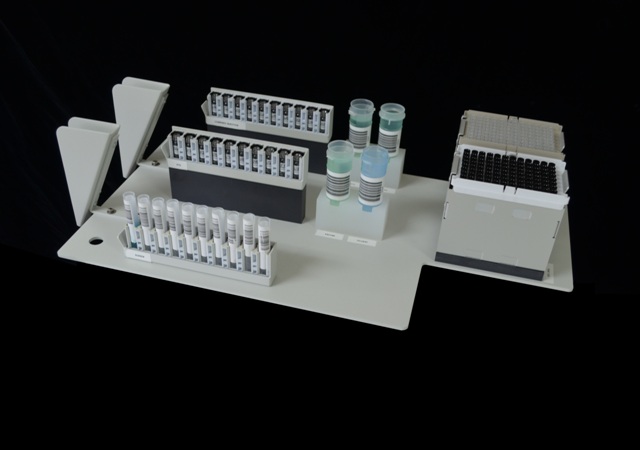This instrument is designed to provide automated sample prep in forensic urine drug testing laboratories. The instrument can perform all of the following in 2 minutes per specimen:
The MC300 features a removable/swappable deck containing a labware layout. The deck may be designed to incorporate multiple destination racks, and multiple reagent or diluent sources, as well as a location for a specimen container. Also on the deck are one or more pipette tip racks. The MC300 allows the user to choose from multiple tip sizes, to meet accuracy requirements. The instrument combines automated liquid handling with optional integrated vial opener and barcode scanning.
The instrument reads the sample barcode, looks up how much sample fluid and other reagents are to be dispensed into the instructed destination tubes via a recipe file, and then performs the aliquot sequence, resulting in samples or mixtures sorted by workflow; ready for analysis. The instrument automatically indexes the next available destination tube in each user defined workflow for the next sample. When the sample is complete the instrument writes an output file to the network, where the LIMS system picks it up and associates the destination barcodes with the sample barcode. The software introduces user configurable machine profiles, which allows the user to select the current profile associated with a particular deck layout and workflow type.
The software allows the user to choose to run a selectable profile. The user defined profiles determine the mode of operation (static or dynamic workflow file), chain of custody rules, and associated deck layout and fluid parameters. The profile also points to a user configured recipe file, which determines the aliquot sequence, volumes, pipette tips, and expected vial barcode values.
The instrument uses a single channel Tecan air displacement pipettor, and uses disposable tips. Pipetting performance is shown below
| DiTi (uL) | Volume (uL) | Dispense | Point Accuracy | Precision (CV) |
| 10 | 1 | Single | ≤5% | ≤6% |
| 10 | 5 | Single | ≤ 2.5% | ≤1.5% |
| 10 | 10 | Single | ≤1.5% | ≤1% |
| 50 | 5 | Single | ≤5% | ≤2% |
| 50 | 10 | Single | ≤3% | ≤1% |
| 50 | 50 | Single | ≤2% | ≤0.75% |
| 200 | 10 | Single | ≤5% | ≤2% |
| 200 | 50 | Single | ≤2% | ≤0.75% |
| 200 | 200 | Single | ≤1% | ≤0.75% |
| 1000 | 10 | Single | ≤7.5% | ≤3.5% |
| 1000 | 100 | Single | ≤2% | ≤0.75% |
| 1000 | 1000 | Single | ≤1% | ≤0.75% |
| 1000 | 100 | Multi | ≤3% | ≤2% |
The pipettor uses automated liquid level detection, and aspirate/dispense rates up to 1000 uL/sec.
Recipe files and Profiles work together to provide a high degree of flexibility. While the profile defines the deck layout and other parameters of the machine, the Recipe file tells the machine what aliquot sequence to perform.
Recipe files are simple text .csv files that can be generated using a text editor or a spreadsheet program like Microsoft Excel. The sample below shows a recipe for a sequence in which a specimen is mixed with various sources into multiple destination racks.
| TIPS:1000uL | SOURCE:SPECIMEN CONTAINER | SAMPLEID:ALL | DESTINATION:SCREEN#1000 | |
| TIPS:200uL | SOURCE:SPECIMEN CONTAINER | SAMPLEID:ALL | DESTINATION:ETG#40 | DESTINATION:COMBINED INJECTION#50 |
| TIPS:200uL | SOURCE:ENZYME | SAMPLEID:13670 | DESTINATION:COMBINED INJECTION#20 | |
| TIPS:200uL | SOURCE:INTERNAL STANDARD | SAMPLEID:13567 | DESTINATION:COMBINED INJECTION#20 | DESTINATION:ETG#20 |
| TIPS:200uL | SOURCE:BUFFER | SAMPLEID:13669 | DESTINATION:COMBINED INJECTION#25 | |
| TIPS:1000uL | SOURCE:DILUENT | SAMPLEID:13554 | DESTINATION:ETG#250 |
Deck layouts may be quickly swapped, and each layout can be customized to the unique requirements of the workflows.
In the example shown below, there are two tip sizes (200uL and 1000uL), 4 additional sources (reagents), and 3 workflow racks. In the front row is a screening tube rack with a linear barcode, the middle row has an ETG vial rack with 2mL vials printed with unique 2d barcodes, and the back row has a combined injection 2mL vial rack also printed with 2d barcodes.

When a new specimen is first read, the instrument checks the recipe file and determines the number of required liquid transfers, and creates a record for each one. It then inserts
As the instrument performs the aliquot sequences, it checks that the correct sources are being drawn from. If it encounters an unexpected barcode read during an aliquot sequence, it stops and the software informs the technician of the issue. This feature eliminates the possibility of aspirating fluid from an incorrect source.
Similarly, when a new destination tube or vial is first read, the instrument checks the records associated with the current specimen. It then inserts
As the instrument performs the liquid handling tasks for the specimen, it checks that the correct destination ID is read immediately prior to dispensing into the vial. If it barcode scans an unexpected vial, it stops and the software informs the technician of the issue. This feature eliminates the possibility of dispensing fluid into an incorrect vial.
The instrument keeps track of the positions of the destinations as it works through their racks, and calculates the correct position for each dispense, including after resumption of an incomplete batch or incomplete sample.